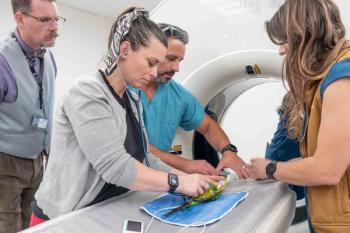
Using ultrasound to detect free abdominal fluid
Ultrasound is very sensitive at picking up free fluid in the peritoneal space. Depending on the patient, free fluid may be an important finding in diagnosing abdominal disease. The character and the amount of fluid are important indicators for the composition and cause of the effusion.
Ultrasound is very sensitive at picking up free fluid in the peritoneal space. Depending on the patient, free fluid may be an important finding in diagnosing abdominal disease. The character and the amount of fluid are important indicators for the composition and cause of the effusion.
Small amount of anechoic fluid
The best places to detect a small amount of effusion are between the liver lobes (Image 1) or next to the bladder. Near the liver, the fluid dissects between liver lobes or between the liver and the diaphragm, allowing you to see these structures separately.
A small anechoic effusion (arrow) separates two liver lobes.
A small amount of anechoic effusion will be located in the cranial, caudal or dependent portion of the abdomen, or may appear as small triangular areas between bowel loops. Young animals often have a small amount of normal fluid in the abdomen as a normal finding. In older animals, hypoproteinemia or overhydration can cause a transudate or modified transudate to form.
Mild systemic disease such as IBD is another potential cause of a small effusion. If the amount of fluid is minimal, anechoic, and there is no evidence of abdominal disease, it is most likely to be a benign cause.
Moderate/marked amount of anechoic fluid
A more concerning finding is a moderate amount of anechoic fluid. Although the amount is subjective, moderate fluid levels are easy to see, and obviously separate the liver lobes and infiltrate between the intestine and other organs.
Anechoic fluid often is of low cellularity and can be a transudate or modified transudate. Causes such as heart failure can be supported by evaluating the hepatic vein size and the history of the animal. Enlarged hepatic veins are readily visualized using ultrasound, and indicate right heart failure.
Hypoproteinemia from gastro-intestinal or renal disease also can cause effusion. It's worth checking the liver and portal vein for evidence of portal hypertension, such as a nodular liver, hepatofugal blood flow in the portal vein or thrombosis. Portal hypertension causes fluid to exude from the liver itself because of increased hydrostatic pressure.
Acute inflammation also can cause an anechoic effusion, though inflammatory effusions often are echogenic by the time the ultrasound is performed. The history and lab findings often are helpful in narrowing down the differentials and focusing the ultrasound exam.
Moderate/marked amount of echogenic fluid
Echogenic fluid has small suspended particles that look like flecks of white and swirl with agitation or breathing (Image 2). It can be helpful to compare the effusion to the urine in the bladder (Image 2) because the urine normally is anechoic. An echogenic effusion often means that the fluid is cellular, such as a supprurative, hemorrhagic or neoplastic effusion, or is proteinaceous.
A moderate echogenic effusion surrounds the anechoic urine in the bladder.
In Image 3, a photograph of the urine (right) and effusion (left) of the dog in Image 2, the echogenic effusion was a modified transudate with 4.9 g/dl protein and 20,000 red blood cells/ul.
The effusion (left) and urine (right) of the dog in image 2, obtained with ultrasound guidance.
Secondary findings are helpful in determining the origin of the effusion. A splenic mass or hepatic mass would lead you toward diagnosing a hemorrhagic effusion, while an intestinal mass with surrounding hyperechoic mesentery and localized effusion indicates ruptured bowel and suppurative effusion.
The key points are to decide if it is generalized or localized, to look for a mass (non-GI or GI) and to evaluate the mesentery. Neoplastic effusions can form from carcinomatosis, which results in a mesentery that is diffusely thickened with ill-defined hypoechoic nodules. Primary sites of neoplasia leading to carcinomatosis include bladder, GI and prostate.
For a definitive diagnosis of the composition of the effusion, paracentesis is required. The best places to aspirate small amounts of fluid are in the cranial and caudal areas of the abdomen. I often orient the transducer parallel to the table and search for a pocket in the dependent part of the abdomen. Fluid pockets often form near the bladder or between the bowel and body wall. Take care not to touch nearby bowel and bladder when placing the needle for an ultrasound-guided paracentesis.
There are many causes of peritoneal effusion, and ultrasound is very sensitive at detecting them. In general, anechoic effusions tend to be more benign, and echogenic effusions more infectious/inflammatory or malignant. If you detect effusion, focus your ultrasound examination on focal change that could cause effusion, or for signs of more general disease leading to a hydrostatic cause for effusion.
Dr. Zwingenberger is a veterinary radiologist at the University of California-Davis.
Newsletter
From exam room tips to practice management insights, get trusted veterinary news delivered straight to your inbox—subscribe to dvm360.






